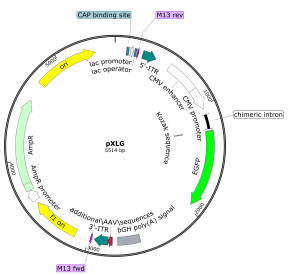Overview of our mammalian expression vectors
For transient expression of single proteins in mammalian cells, we mainly use the pXLG vector, which was a kind gift from David Hacker from the EPFL (Switzerland).
We also have a collection of mammalian expression vectors specifically adapted for ligation-independent cloning. These vectors are called pCoofy vectors and were developed by Sabine Suppmann at the Max Planck Institute for Biochemistry in Martinsried, Munich.
The detailed cloning protocols and descriptions of these vectors can be found in the following reference:
Scholz J., Besir H., Strasser S. and Suppmann S. (2013) A new method to customize protein expression vectors for fast, efficient and background free parallel cloning. BMC Biotechnology. 13:12
Internal EMBL users can obtain these vectors at the Protein Expression and Purification Core Facility. External users can request them via Addgene.
Mammalian pCOOFY expression vectors
| Name | N-terminal tag | C-terminal tag | Antibiotic resistance | Backbone |
|---|---|---|---|---|
| pCoofy47 | VEGFss-3C | * His10 * TwinStrepII * S-tag * CBP | Ampicillin | pTT5 |
| pCoofy50 | HA-His8-Flag-3C | His10 | Ampicillin | pEF-HA |
| pCoofy55 | His10-SumoStar-3C | * His10 * TwinStrepII * S-tag | Ampicillin | pTT5 |
| pCoofy56 | TwinStrepII-3C | His10 | Ampicillin | pEF-HA |
| pCoofy57 | VEGFss-His8-3C | * His10 * TwinStrepII * S-tag * CBP | Ampicillin | pTT5 |
| pCoofy58 | VEGFss-TwinStrepII-3C | * His10 * TwinStrepII * S-tag * CBP | Ampicillin | pTT5 |
| pCoofy62 | VEGFss-His6-SumoStar | * none * His10 * TwinStrepII * EPEA-tag | Ampicillin | pTT5 |
